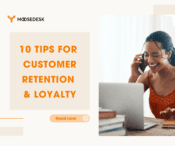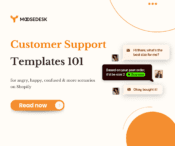Mastering The Art Of Customer Onboarding For Shopify Stores
Mastering The Art Of Customer Onboarding For Shopify Stores
Customer onboarding marks the crucial transition from sign-up to product proficiency for users. This pivotal phase shapes their entire experience, impacting satisfaction, retention, and overall business success. Mastering this process has become essential in a competitive landscape, setting the stage for exceptional user experiences right from the start.
In this article, we will explore the most essential factors of customer onboarding on Shopify. But first, let’s break it down into these specific parts:
What is customer onboarding?
Customer onboarding is the nurturing procedure designed to familiarize new users with your products and services. A customer onboarding process involves step-by-step tutorials, valuable guidance, and celebrations when a customer achieves milestones utilizing your product or service.
This process aims to provide value to your users, ensuring they repeatedly engage with your product and seamlessly integrate it into their daily work routine.
The best customer onboarding strategies focus on the buyer’s goals, offering clear and detailed instructions to effectively utilize the product in achieving these objectives.
The importance of customer onboarding
Customer onboarding is essential as it shapes users’ initial interaction with your product, setting the tone for their entire journey. It accelerates the time for users to grasp the value of your offering, increases customer lifetime value, and reduces churn rate.
Additionally, it helps enhance customer engagement, paving the way for higher satisfaction and extended retention.
Here are a few facts from Hubspot that highlight the significance of the onboarding process:
- The majority of revenue often stems from existing customers
- Happy customers can become your top referral sources
- Customer retention can reduce acquisition costs and boost revenue
In conclusion, user onboarding plays a critical role in improving customer retention, consequently fueling your business growth.
Customer onboarding process
Sign-up process
The sign-up stage is the first part of the onboarding process.
Heap surveyed 79 SaaS companies and discovered that the typical conversion rate for their sign-up procedure stood at 36,2%.
- Keep your sign-up process short and smooth: Initiate your customers for success right from the start by simplifying the process of getting them started with your product. At this stage, requesting only a name, email address, and password should be adequate.
- Require an extensive amount of information for sign-up? Instead of requesting all details on a single page, divide it across multiple pages. Spreading out the sign-up information over several pages was associated with a slight uptick in conversion rates. Thus, if your sign-up process demands a lot of customer information, take it easy by splitting it across multiple pages.
- Offering integration with familiar services such as Google, Slack,… This eliminates almost the friction during sign-up, enabling new customers to register with just a single click. “When people can register with one click using a service they already use like Google, Slack,…the signup rates improved 8.2 percentage points.” (Heap)
Why is it good?
- Short form: It doesn’t require lots of information
- No credit card required
- Concise, easily digestible bullet points are placed next to the form, reiterating the benefits customers will receive upon signing up.
Why is it good:
- There’s only one field to fill in to begin, keeping it brief.
- Customers have the option to sign up using other tools they already use.
Welcome email
After the user’s registration, the next step in your onboarding process involves sending them a welcome email. This email should promptly guide them back to your product, enabling them to start using it and derive value from it right away.
- Express appreciation: Extend your thanks. These users have taken the time to sign up for your product, so it’s important to communicate that you value them.
- Send helpful resources: Incorporate links to onboarding resources such as product tours, demo videos, knowledge base articles, or FAQs. However, it’s crucial not to overwhelm the customer with excessive information at this early stage in the process.
- Encourage users to use your product: The main objective of this email is to encourage your new users to log in to experience your product. Including a CTA in your email can motivate them to get started.
First log-in
Even if a user has viewed a demo or gone through a tour, their initial log-in is their first real impression of your product.
During this phase, your goal is to help them set up and become prepared to utilize your product. Typically, it involves providing a guided tutorial or set-up wizard that walks your customers through each step of the process.
- Provide precise instructions to your customers: Avoid leaving them to speculate; instead, offer valuable information or tools, such as a setup wizard, immediately upon their login.
- Offer a simple victory: Since it may require time for users to fully appreciate your product’s value, you should offer a swift achievement to boost their confidence. This could entail something as straightforward as “leveling up” in the onboarding process or earning a badge for completing a specific action.
- Provide a “getting started” checklist: Develop an outline or checklist of what tasks new users should complete and what they can anticipate throughout the onboarding process.
Integrations and Invitations
For B2B companies, the onboarding process often encompasses various team members and tools. Your addition to their tech stack typically isn’t standalone software, rather, it’s a product that necessitates integration with other systems. This often involves importing data and inviting members to join the workspace.
- Leverage automation: You should automate as much of the process as possible to eliminate bottlenecks that may cause issues for your users.
- Provide options: Not every customer might require setting up platform integrations, importing data, or inviting other users to join their team. Hence, ensure that this stage remains an optional component of your onboarding process.
- Deliver exceptional support: Make sure you have a support team to address all customer issues during this stage.
Product walkthrough or tutorial
A product walkthrough guides your customers through the necessary steps to set up and accomplish essential tasks within your product. The objective is to motivate users to complete essential tasks within the product.
- Enable customers to skip certain sections of the process. Some users might have prior familiarity with your product from previous roles. You can provide them the option to skip parts or the entirety of the tutorial to ensure there are no obstacles to them when using the product.
- Enable a pause feature. Some prefer not to go through an entire onboarding tutorial in one sitting. Therefore, it’s crucial to offer your customers the flexibility to pause the product walkthrough and return to it whenever necessary.
- Offer extra assistance: Some users might need more than just a product walkthrough or tutorial when using your product. Make sure all customers can reach support agents for extra help. Alternatively, consider providing a live chat support feature for immediate assistance.
Follow-up email
Your onboarding process aims to maintain customer engagement beyond their initial login.
You have to consider sending subsequent follow-up emails that provide helpful tips to assist your customers in utilizing your product and encourage them to log back in through these communications.
- Offer assistance, not sales pitches: Rather than pushing for an upgrade or promoting another product, concentrate on nurturing the relationship established with your customer through this specific product. Share resources such as links to help center articles and videos detailing specific features to assist users in maximizing the benefits of your company’s products.
- Keep it concise. According to Constant Contact’s analysis of over 2.1 million emails, the ones with the highest click-through rates had about 20 lines of text, roughly equivalent to 200 words. Ensure your communication centers around one topic or usage scenario to avoid overwhelming readers.
- Utilize social proof: Embedding customer testimonials and reviews within your follow-up emails to remind your users about the value of your product.
Customer On-boarding Best Practices
Show your value
Showcasing your value serves as the foundation for a lasting relationship. You need to highlight the unique benefits and solutions your product offers to your customers.
You have to show how your product solves their problems engages them and proves its immediate value. By consistently highlighting what you offer during onboarding, customers understand its significance, building trust and strengthening their loyalty to your brand.
Improve communication
Clear, concise, and timely communication at each stage ensures customers comprehend the steps involved, reducing confusion and enhancing their experience. You should provide multiple channels for communication, such as live chat, email, or guided tutorials to empower customers to seek assistance when needed.
Keeping customers updated and reaching out proactively shows your commitment. It helps keep customers informed and engaged during onboarding, laying a strong foundation for a successful relationship.
Create an amazing experience
Every customer has distinct concerns, so you should provide a personalized experience. The more you customize your solution to meet their needs, the easier it will be to achieve wins.
Additionally, ensure availability to assist customers getting stuck. This enhances their onboarding experience and provides insights into areas where your process might need improvement.
Utilize customer support system
Leveraging a robust customer support system within your onboarding process is crucial for a smooth journey. It ensures timely assistance and guidance for new users navigating your product.
Moreover, utilizing customer support interactions helps you learn and improve the onboarding process by finding and fixing issues.
Measure the success of customer onboarding
To gauge onboarding success effectively, it’s advisable to collect various metrics. This approach provides a comprehensive understanding of customers’ sentiments and actions.
>> Discover these 10+ Help Desk Metrics To Measure Support Performance On Shopify
Wrapping Up
In summary, customer onboarding serves as the bedrock for establishing strong relationships and driving customer success. It’s a crucial stage where businesses can make a lasting impact, meet user needs, and demonstrate their value. By focusing on clear communication, personalized assistance, and ongoing support, companies can elevate the onboarding experience. A well-executed onboarding strategy not only enhances retention but also cultivates lasting satisfaction, loyalty, and mutual growth between businesses and their customers.
Interested in customer onboarding? Learn more about our Shopify tactics for growing merchants!





